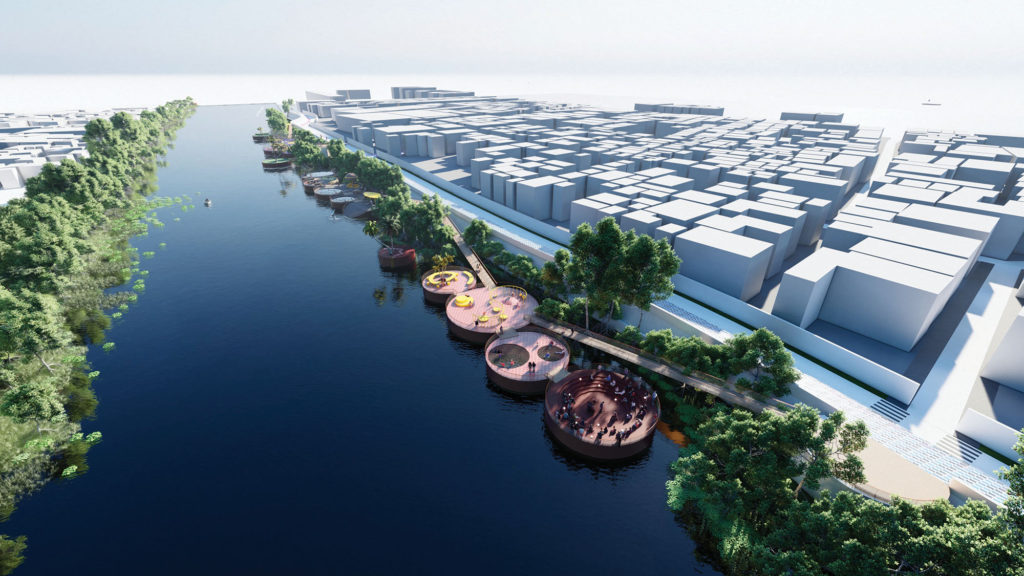Master-planning Happier Philippine Cities
December 7, 2022
Many of the social, economic and environmental issues affecting our cities can be ascribed to the uncontrolled urbanisation of the past century. These changes are the aftermath of a model of progress that also believes in sacrificing the natural environment to make way for industry and economic growth. Among the ‘victims’ of such beliefs are the public spaces that are undoubtedly vital to cities.

There exist two predominant contending models of cities. City A is one full of luxury apartments, shopping malls, skyways, and gated communities encouraging consumption. Residents work hard to afford products that they believe will grant them personal pleasure. Here, possessions represent the highest pursuit of happiness. City B is one peppered with plazas, public parks, pedestrian-only walkways and busy sidewalks encouraging social interaction. Happiness in this model comes from a sense of community where socialising is deemed vital to well-being and quality of life.
But why is happiness, whether it comes from consumption or interaction, so important? Because it is human nature to seek happiness. This article seeks to advocate a more equitable, connected city—City B as described above—and how we, as designers, should master-plan cities that will make residents happy to live, work and play in. Simply put, it is a reminder not to crowd out accessible public spaces in favour of progress.
PUBLIC SPACES AND THE PURSUIT OF URBAN HAPPINESS
The most sustainable public spaces are freely used by a diverse mix of communities, and they prompt creative discovery, promote tolerance and understanding, and augment the everyday quality of life. More importantly, public spaces do not discriminate between the participant and the spectator—all are on the stage and, at the same time, the audience.
Public spaces are crucial to humanising the metropolitan environment. The challenge of planning and designing such places is to balance certain urban issues with human behaviours so they may generate a prevailing feeling of happiness. Urban happiness is an observable concept visible in the many tangible and intangible aspects of a place carried out and experienced by those who use it1. We use our senses daily, so it comes as no surprise that places with more pleasant sensory experiences tend to be more desirable. It follows that urban happiness is also a set of attributes and experiences that give a place a positive perception of well-being to cause residents to stay for longer periods of time.


A HAPPY CITY PRESENTS A KALEIDOSCOPE OF REGENERATIVE PUBLIC SPACES
A happy city is the palpable link between well-being and urban planning. This concept takes a kaleidoscopic approach that translates the conditions for urban happiness into public spaces to further improve quality of life. The model for happier cities includes the following key components.


Public urban amenities offer spaces without barriers and a range of stimuli: children playing on a bridge in Manila, jumping down to the river despite its murky waters
Urban green spaces
In Bonifacio Global City (BGC), an urban farming initiative called the BGC Community Farm by Urban Farmers is led by UFSCOI (Urban Farmers Sustainability Concepts Organization, Inc.), a social enterprise that aims to make use of idle lands and turn them into temporary productive farms to give jobs to displaced workers. Upon a 1,500 square-metre property lent by Fort Bonifacio Development Corporation (FBDC) and Ayala Estates, residents and visitors are encouraged to locally grow and cultivate produce in the heart of the city.
Another programme proposed by WTA called The Green Matrix aims to counter the ‘mall culture’ in Manila by propagating an ecological system that grows and extends throughout the city. It links and cultivates disconnected green spaces by integrating them into an existing park that extends to Manila Bay. This urban ecosystem involves vegetated buffer zones with stormwater planters that harvest rainwater to recharge the water table below and saturate plant beds above. True to its name, it plans a matrix of recreational green spaces that revitalises and charts a sustainable route towards Greener and more liveable cities.
[This is an excerpt. Subscribe to the digital edition or hardcopy to read the complete article.]

Patricia Antoinette Ko is an architecture student at the University of the Philippines. She doesn’t believe in a one-size-fits-all approach to the built environment and advocates adaptable, localised solutions that take into account sustainability, culture, and public health. Informed by personal urban experiences, Patricia believes that architects and planners must explore more pathways and strategies to create happier, more equitable, and more resilient cities. She is also an in-house writer at WTA Architecture and Design Studio.
Related stories from Philippine Focus:
Quezon City: Setting up an infrastructure of sustainability


Read more stories from FuturArc 4Q 2022 Year-End Issue!

To read the complete article, get your hardcopy at our online shop/newsstands/major bookstores; subscribe to FuturArc or download the FuturArc App to read the issues.
Previously Published Commentary
Contact us at https://www.futurarc.com/contact-us for older commentaries.
